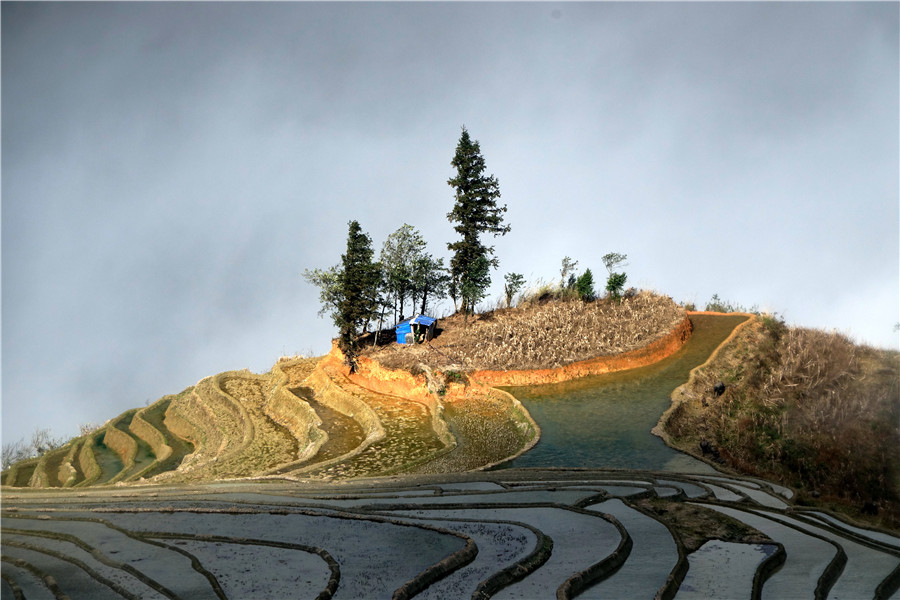
Travel to Azheke Village and Azheke Rice Terraces in Yuanyang County


Here is the entrance to the village of Azke, and the street sign at the entrance has the following text:
Azheke, in Hani language means a place with bamboo forest. Azheke village is located in the center of Honghe (红河)World Heritage area, which is 52 kilometers from Nansha (南沙)town and altitude is 1,920 meters. There are totally 61 households with 396 persons in Hani native village. This village is one of the most intact domestic Hani old villages and was recorded in the third batch of Chinese traditional village directory.
Seeing is believing. The stone road passes through the jungle and After walks six or seven minutes, we can saw the village of AZeKe. Mushroom room, thick grass top, adobe is wall. 


After seeing the mushroom house I could not help speed up the pace of entering the village. There is a mountain spring on the side of the road to flow down the mountain.Look carefully at the water pipes and the water pipes. The water pipes are very thin. It seems to be a private water pipe. The things in front are not easy to understand, it looks like a water tank, right?Not like it. The long stone wall, followed by a stone water pipe, inside is a sink, overflowing clean water flows down the pipe, and a manger is placed under each pipe. Apparently suitable for hinny to drink water here. Is this the original public tap water? I guess so. 
Villagers’ house are built with stable mud walls and thick grass roof top, natives call it “Mushroom house”. The structure can stop the strong wind and heavy rain, more important, it can make the room very comfortable to live. The “Mushroom house” normally has three floors, the ground(first) floor is used for keeping some animals for example, chicken, pigs…The second floor is for living, while the third floor can store food.




The village is quiet and natural. With the exception of a few signs, there was no atmosphere of tourist spots at all. Several old women were chatting and the children were playing freely. 

In front of the village is the sacrifice site. Maybe the tall tree on the edge of the venue is the dragon tree. In the southern bank of the Honghe Hani society, there’re primary and secondary gods and ghosts. The primary gods are God of Heaven, God of Earth, God of Mountain, God of Zhai and God of Family. These gods are very important and should be worshipped together in the sacrifice ceremony. Dragon Tree is regarded as the protector of human beings and sacrifice is held every year to worship him.

 The sacrifice site was by the side of the village, and then it went into the terraces. Not far away, I saw the man who drove the mule to carry the brick. I thought the slag brick was used to build the house. Only then did I understand that the brick was used to repair the rice field. The men fainted the brick by the side of the road and transported it from the side of the road to the field. It was hard for Hani women about life.
The sacrifice site was by the side of the village, and then it went into the terraces. Not far away, I saw the man who drove the mule to carry the brick. I thought the slag brick was used to build the house. Only then did I understand that the brick was used to repair the rice field. The men fainted the brick by the side of the road and transported it from the side of the road to the field. It was hard for Hani women about life.



Though I have been to many attractions at different times and consider that I already fully understood the beauty of terrace field. However, I found myself totally wrong till I was here.












http://blog.sina.com.cn/s/blog_bd31f68c0102yd51.html
阿者科村/Azheke Village
阿者科村蘑菇房/Mushroom Houses in Azheke Village

 7 Days GolfingTour
7 Days GolfingTour
 8 Days Group Tour
8 Days Group Tour
 8 Days Yunnan Tour
8 Days Yunnan Tour
 7 Days Shangri La Hiking
7 Days Shangri La Hiking
 11 Days Yunnan Tour
11 Days Yunnan Tour
 6 Days Yuanyang Terraces
6 Days Yuanyang Terraces
 11 Days Yunnan Tour
11 Days Yunnan Tour
 8 Days South Yunnan
8 Days South Yunnan
 7 Days Tea Tour
7 Days Tea Tour
 8 Days Muslim Tour
8 Days Muslim Tour
 12 Days Self-Driving
12 Days Self-Driving
 4 Days Haba Climbing
4 Days Haba Climbing
 Tiger Leaping Gorge
Tiger Leaping Gorge
 Stone Forest
Stone Forest
 Yunnan-Tibet
Yunnan-Tibet
 Hani Rice Terraces
Hani Rice Terraces
 Kunming
Kunming
 Lijiang
Lijiang
 Shangri-la
Shangri-la
 Dali
Dali
 XishuangBanna
XishuangBanna
 Honghe
Honghe
 Kunming
Kunming
 Lijiang
Lijiang
 Shangri-la
Shangri-la
 Yuanyang Rice Terraces
Yuanyang Rice Terraces
 Nujiang
Nujiang
 XishuangBanna
XishuangBanna
 Spring City Golf
Spring City Golf
 Snow Mountain Golf
Snow Mountain Golf
 Stone Mountain Golf
Stone Mountain Golf




